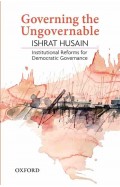Pakistan Economic Challenges And Solutions
By: Dr. Ishrat Husain, Sarah Nizamani, Shagufta Shabbar and Masood Siddiqui
-
Rs 2,970.75
- Rs 3,495.00
- 15%
You save Rs 524.25.
Due to constant currency fluctuation, prices are subject to change with or without notice.
Pakistan faces a multitude of economic challenges some of them man made and domestic and the other external and natural. There is very little disagreement on the diagnostics — weak institutions, low productivity. Low savings and investment, burgeoning burden of debt, Macroeconomic instability, poor human capital, indifferent bureaucracy, tough business climate, inefficiencies in energy sector etc. This volume consisting of fourteen chapters attempts to bring together at one place the well-known prescriptions and detailed solutions to address these challenges.
The main insight arising from this work is that a lot has been done to define the contents and the contours of reforms but the asymmetry in the accrual of losses and gains is the main stumbling block to their implementation. As losses are immediate, the losers are identifiable, organized groups that agitate and resist the reforms eroding the political capital of the ruling party weakening their chances at electoral cycle. Successive governments have therefore found hardly any champions among the elected representatives. Given that the gains would occur sometime in distant future and would be diffused throughout the economy the credit for success would be preempted by the party in opposition in power at that time strengthening its chances of getting reelected. This disconnect between the timing of political and economic gains and losses thus leads to the maintenance of status quo.
- SHARE ON FACEBOOK
Pakistan faces a multitude of economic challenges some of them man made and domestic and the other external and natural. There is very little disagreement on the diagnostics — weak institutions, low productivity. Low savings and investment, burgeoning burden of debt, Macroeconomic instability, poor human capital, indifferent bureaucracy, tough business climate, inefficiencies in energy sector etc. This volume consisting of fourteen chapters attempts to bring together at one place the well-known prescriptions and detailed solutions to address these challenges.
The main insight arising from this work is that a lot has been done to define the contents and the contours of reforms but the asymmetry in the accrual of losses and gains is the main stumbling block to their implementation. As losses are immediate, the losers are identifiable, organized groups that agitate and resist the reforms eroding the political capital of the ruling party weakening their chances at electoral cycle. Successive governments have therefore found hardly any champions among the elected representatives. Given that the gains would occur sometime in distant future and would be diffused throughout the economy the credit for success would be preempted by the party in opposition in power at that time strengthening its chances of getting reelected. This disconnect between the timing of political and economic gains and losses thus leads to the maintenance of status quo.
- SHARE ON FACEBOOK
Pakistan The Economy of an Elitist State
By: Dr. Ishrat Husain, Sarah Nizamani, Shagufta Shabbar and Masood Siddiqui
Rs 927.00 Rs 1,030.00 Ex Tax :Rs 927.00
Pakistan Economic Challenges And Solutions
By: Dr. Ishrat Husain, Sarah Nizamani, Shagufta Shabbar and Masood Siddiqui
Rs 2,970.75 Rs 3,495.00 Ex Tax :Rs 2,970.75
Governing the Ungovernable
By: Dr. Ishrat Husain, Sarah Nizamani, Shagufta Shabbar and Masood Siddiqui
Rs 1,345.50 Rs 1,495.00 Ex Tax :Rs 1,345.50
Development Pathways
By: Dr. Ishrat Husain, Sarah Nizamani, Shagufta Shabbar and Masood Siddiqui
Rs 3,145.50 Rs 3,495.00 Ex Tax :Rs 3,145.50
Zubin Mehta: A Musical Journey (An Authorized Biography)
By: VOID - Bakhtiar K. Dadabhoy
Rs 892.50 Rs 1,050.00 Ex Tax :Rs 892.50
Engineers: From the Great Pyramids to Spacecraft
By: Adam Hart-Davis
Rs 4,670.75 Rs 5,495.00 Ex Tax :Rs 4,670.75
The Wires of War - Technology and the Global Struggle for Power
By: Jacob Helberg
Rs 3,735.75 Rs 4,395.00 Ex Tax :Rs 3,735.75
Development Pathways
By: Dr. Ishrat Husain, Sarah Nizamani, Shagufta Shabbar and Masood Siddiqui
Rs 3,145.50 Rs 3,495.00 Ex Tax :Rs 3,145.50
Pakistan The Economy of an Elitist State
By: Dr. Ishrat Husain, Sarah Nizamani, Shagufta Shabbar and Masood Siddiqui
Rs 927.00 Rs 1,030.00 Ex Tax :Rs 927.00
Beyond Good and Evil (Penguin Classics)
By: Friedrich Nietzsche
Rs 2,245.50 Rs 2,495.00 Ex Tax :Rs 2,245.50
Governing the Ungovernable
By: Dr. Ishrat Husain, Sarah Nizamani, Shagufta Shabbar and Masood Siddiqui
Rs 1,345.50 Rs 1,495.00 Ex Tax :Rs 1,345.50
Viva Dictionary Of Punctuation And Hyphenation
By: William Gould
Rs 127.50 Rs 150.00 Ex Tax :Rs 127.50
And Another Thing... (The Hitchhiker's Guide to the Galaxy)
By: Eoin Colfer
Rs 355.50 Rs 395.00 Ex Tax :Rs 355.50
Collins Pocket Italian Dictionary
By: Collins Dictionaries
Rs 1,847.50 Rs 3,695.00 Ex Tax :Rs 1,847.50
Engineers: From the Great Pyramids to Spacecraft
By: Adam Hart-Davis
Rs 4,670.75 Rs 5,495.00 Ex Tax :Rs 4,670.75
The Wires of War - Technology and the Global Struggle for Power
By: Jacob Helberg
Rs 3,735.75 Rs 4,395.00 Ex Tax :Rs 3,735.75
Development Pathways
By: Dr. Ishrat Husain, Sarah Nizamani, Shagufta Shabbar and Masood Siddiqui
Rs 3,145.50 Rs 3,495.00 Ex Tax :Rs 3,145.50
Pakistan The Economy of an Elitist State
By: Dr. Ishrat Husain, Sarah Nizamani, Shagufta Shabbar and Masood Siddiqui
Rs 927.00 Rs 1,030.00 Ex Tax :Rs 927.00
Beyond Good and Evil (Penguin Classics)
By: Friedrich Nietzsche
Rs 2,245.50 Rs 2,495.00 Ex Tax :Rs 2,245.50
Governing the Ungovernable
By: Dr. Ishrat Husain, Sarah Nizamani, Shagufta Shabbar and Masood Siddiqui
Rs 1,345.50 Rs 1,495.00 Ex Tax :Rs 1,345.50
Coffee Creations - 90 Delicious Recipes for the Perfect Cup
By: Celeste Wong
Rs 4,315.50 Rs 4,795.00 Ex Tax :Rs 4,315.50
Givenchy Catwalk: The Complete Collections
By: Alexandre Samson
Rs 21,145.50 Rs 23,495.00 Ex Tax :Rs 21,145.50
Zubin Mehta: A Musical Journey (An Authorized Biography)
By: VOID - Bakhtiar K. Dadabhoy
Rs 892.50 Rs 1,050.00 Ex Tax :Rs 892.50
Pakistan The Economy of an Elitist State
By: Dr. Ishrat Husain, Sarah Nizamani, Shagufta Shabbar and Masood Siddiqui
Rs 927.00 Rs 1,030.00 Ex Tax :Rs 927.00
Pakistan Economic Challenges And Solutions
By: Dr. Ishrat Husain, Sarah Nizamani, Shagufta Shabbar and Masood Siddiqui
Rs 2,970.75 Rs 3,495.00 Ex Tax :Rs 2,970.75
Governing the Ungovernable
By: Dr. Ishrat Husain, Sarah Nizamani, Shagufta Shabbar and Masood Siddiqui
Rs 1,345.50 Rs 1,495.00 Ex Tax :Rs 1,345.50
Development Pathways
By: Dr. Ishrat Husain, Sarah Nizamani, Shagufta Shabbar and Masood Siddiqui
Rs 3,145.50 Rs 3,495.00 Ex Tax :Rs 3,145.50
Engineers: From the Great Pyramids to Spacecraft
By: Adam Hart-Davis
Rs 4,670.75 Rs 5,495.00 Ex Tax :Rs 4,670.75
The Wires of War - Technology and the Global Struggle for Power
By: Jacob Helberg
Rs 3,735.75 Rs 4,395.00 Ex Tax :Rs 3,735.75
Development Pathways
By: Dr. Ishrat Husain, Sarah Nizamani, Shagufta Shabbar and Masood Siddiqui
Rs 3,145.50 Rs 3,495.00 Ex Tax :Rs 3,145.50
Pakistan The Economy of an Elitist State
By: Dr. Ishrat Husain, Sarah Nizamani, Shagufta Shabbar and Masood Siddiqui
Rs 927.00 Rs 1,030.00 Ex Tax :Rs 927.00
Beyond Good and Evil (Penguin Classics)
By: Friedrich Nietzsche
Rs 2,245.50 Rs 2,495.00 Ex Tax :Rs 2,245.50
Governing the Ungovernable
By: Dr. Ishrat Husain, Sarah Nizamani, Shagufta Shabbar and Masood Siddiqui
Rs 1,345.50 Rs 1,495.00 Ex Tax :Rs 1,345.50

















-120x187.jpg?q6)



































